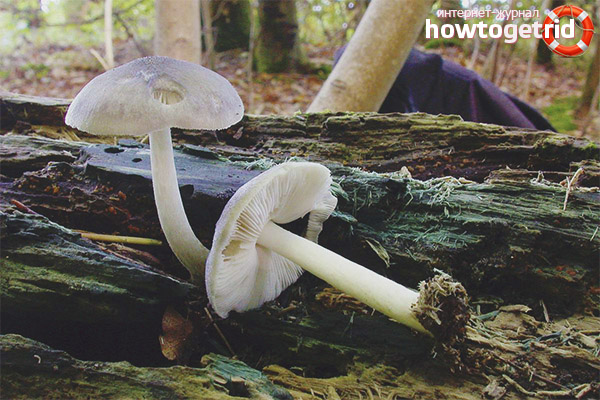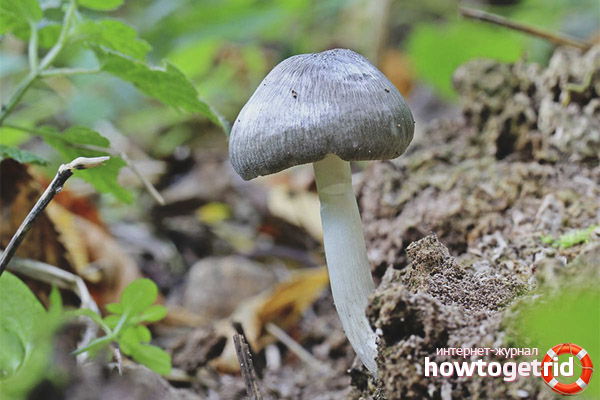The content of the article
Willow twigs - a mushroom of the family of bolbitian, having hallucinogenic properties. The resulting psilocybin syndrome is mainly characterized by a significant increase in the activity of the SNS. The presence of such a substance as psilocybin is primarily indicated by the bluish color of the fungus leg at its base. The Latin term for this species is Pluteus salicinus.
View description
The willow has a hat, the maximum diameter of which reaches 80 mm. At the beginning of the development of the fungus, the hat has a characteristic bell-shaped shape, straightens with growth, becoming more flat-convex. In adult specimens, the cap is fully revealed, the inner part with a small indentation, in the center of which is a low tubercle densely dotted with small scales. The main color of this part of the fungus is gray. The surface is shiny, completely covered with characteristic radial stripes.
The leg of the plutea is cylindrical, rather long, reaches 100 mm, in diameter - no more than 10 mm. The inner part is loose, thickens at the base. The surface of the legs is white, shiny, the base of the legs has a characteristic blue tint.
Places of growth
Most often, willow can be found growing in moist forests of mixed and deciduous type. The most favorite place for the growth of this species of fungi is floodplain areas. Plutea grows both singly and in small groups. Often they settle on rotting wood, felling, near the horses of the trees. This species is especially common in the forests of the northern hemisphere. The fruiting season is from mid-spring to the first frosts.
Edibility and properties
In fact, such a mushroom as willow will be considered edible, that is, it can be eaten, the only important condition for this is the obligatory preliminary boiling. This is due to the fact that with prolonged heat treatment, an active substance such as psilocybin is destroyed, and the use of mushrooms of this type will not harm a person.
The use of raw plutea, as a rule, causes a sufficiently strong psilocybin syndrome, which is manifested by the appearance of hallucinations. A person can begin to hear sounds, see very bright and realistic visions, panic attacks may occur. This effect occurs rather quickly - already after several tens of minutes after eating these mushrooms raw, the duration of this condition is several hours.
Related species
Deer deer is a type of mushroom known to most fans of quiet hunting, which is also called deer mushroom. The hats of this representative of the plutee family are quite large, in some specimens the diameter of the fruiting body can reach solid sizes - up to 200 mm. The color of the cap surface is brownish with different shades (variations - from light to dark). This type of mushroom has spread throughout the planet, most often the place of their growth is wood of trees of different species (both deciduous and coniferous). This mushroom belongs to the edible species, which can be used for cooking culinary dishes.
White whip is a fungus, quick in size (cap diameter - no more than 50 mm). The hat, as is clear from the name of the species, is white, in mature mushrooms it acquires a grayish color. The surface of the cap is densely dotted with brownish villi. Most often, this species can be found growing on the wood of trees in beech groves. This species, although edible, is nevertheless little known. The main place of growth is North Africa, the Western part of the European region and Siberia.
Umbrian whip is a medium-sized mushroom; the cap diameter does not exceed 100 mm; the color of this part of the fungus is umbra or dark brown. The surface of the cap is fleecy, completely mottled with small radial grooves. The place of distribution of this species is the Eurasian continent and North Africa. The species presented to attention are included in the group of conditionally edible mushrooms. Pulp with a slight bitterness, which disappears after heat treatment (it means boiling of mushrooms).











Submit